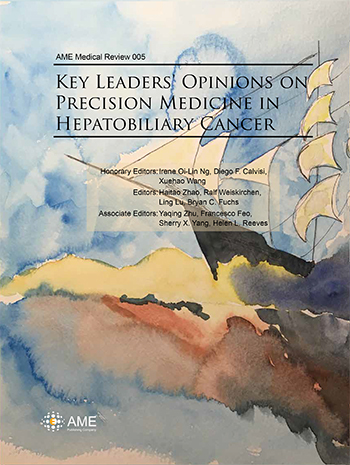
Key Leaders’ Opinion on Precision Medicine in Hepatobiliary Cancer
| Editors: | Haitao Zhao, Ralf Weiskirchen, Ling Lu, Bryan C. Fuchs |
Publisher: AME Publishing Company; 1st edition (2017)
ISBN-13: 978-9887784166
Hardcover: 110 pages
Language: English
Hepatobiliary cancers are among the most prevalent cancers worldwide. With an increasing trend of the incidence of these diseases, there has been a persistent focus in developing new cutting-edge knowledge for the molecular pathogenesis, diagnosis and treatment. In order to understand the advances of research and achieve translational applications in clinical use and precision medicine, a good grasp of the recent advances of research, both basic and clinical, in these cancers is a must.
Honorary Editors
| Irene Oi-Lin Ng | Department of Pathology, and State Key Laboratory for Liver Research, The University of Hong Kong, Hong Kong, China |
| Diego F. Calvisi | Department of Clinical and Experimental Medicine, University of Sassari, Sassari, Italy |
| Xuehao Wang | Academician of the Chinese Academy of Engineering, Liver Transplantation Center, First Affiliated Hospital of Nanjing Medical University, Nanjing, China |
Editors
| Haitao Zhao | Department of Liver Surgery, Peking Union Medical College Hospital, Chinese Academy of Medical Sciences, Beijing, China |
| Ralf Weiskirchen | Institute of Molecular Pathobiochemistry, Experimental Gene Therapy, and Clinical Chemistry, RWTH University Hospital Aachen, Aachen, Germany |
| Ling Lu | Liver Transplantation Center, First Affiliated Hospital of Nanjing Medical University, Nanjing, China |
| Bryan C. Fuchs | Division of Surgical Oncology, Massachusetts General Hospital Cancer Center, Harvard Medical School, Boston, Massachusetts, USA |
Associate Editors
| Yaqing Zhu | Department of Hepatobiliary Surgery, The First Affiliated Hospital, Guangzhou University of Chinese Medicine, Guangzhou 510405, China |
| Francesco Feo | Professor Emeritus of Experiential Pathology, Department of Clinical and Experimental Medicine, Division of Experimental Pathology and Oncology, University of Sassari, Italy |
| Sherry X. Yang | National Clinical Target Validation Laboratory, Division of Cancer Treatment and Diagnosis, National Cancer Institute, National Institutes of Health, Bethesda, Maryland, USA |
| Helen L. Reeves | Northern Institute for Cancer Research, Newcastle University, Newcastle upon Tyne, UK; Newcastle upon Tyne Hospitals NHS Foundation Trust, Newcastle upon Tyne, UK |
Table of Content
Foreword
Preface
Liver Cancer
1 TGFβ signaling: a friend or a foe to hepatic brosis and tumorigenesis
5 A novel role of hepatic epithelial transforming growth factor-β signaling in cholangiocarcinogenesis
8 Vps4A-mediated tumor suppression upon exosome modulation?
11 SETDB1 is a new promising target in HCC therapy
14 Dysregulation of the epigenetic regulator SETDB1 in liver carcinogenesis—more than one way to skin a cat
17 Intratumor heterogeneity, variability and plasticity: questioning the current concepts in classi cation and treatment of hepatocellular carcinoma
22 Are we getting closer to understanding intratumor heterogeneity in hepatocellular carcinoma?
25 Beginnings of a “gene cloud” de nition in hepatocellular carcinoma
27 Multi-omics in prognosis of hepatocellular carcinoma
30 A bridge between multi-omics data and the management of hepatocellular carcinoma
32 Comprehensive characterization of hepatitis B virus-associated multifocal hepatocellular carcinoma using a multi-omics strategy
35 New ‘multi-omics’ approach and its contribution to hepatocellular carcinoma in China
37 Decoding multifocal hepatocellular carcinoma: an opportune pursuit
42 Wading through the noise of “multi-omics” to identify prognostic biomarkers in hepatocellular carcinoma
44 Sulfatase 1: a new Jekyll and Hyde in hepatocellular carcinoma?
49 Epidermal growth factor-like repeats and discoidin I-like domains 3: a multifaceted oncoprotein at the crossroad of MAPK and TGF-beta pathways in human hepatocellular carcinoma
56 STAT3 is a key transcriptional regulator of cancer stem cell marker CD133 in HCC
59 Circulating microRNAs for early detection of hepatitis B-related hepatocellular carcinoma
62 MicroRNAs are key regulators of hepatocellular carcinoma (HCC) cell dissemination—what we learned from microRNA-494
67 Focal loss of long non-coding RNA-PRAL, as determinant of cell function and phenotype of hepatocellular carcinoma
70 Cancer stem cell-associated microRNAs: searching for markers and targets in hepatocellular carcinoma
74 Hormonal control of the metabolic machinery of hepatocellular carcinoma
77 Novel therapeutic strategies targeting liver cancer stem cells
79 Combination PARP and HDAC inhibition as a therapeutic strategy targeting liver cancer stem cells?
83 Response: Chromodomain-helicase-DNA-binding protein 4: a novel therapeutic target in liver cancer stem cells
Gallbladder Cancer
86 Organ-speci c concept and controversy for premalignant lesions and carcinogenesis of gallbladder cancer
89 Response: To improve outcomes of gallbladder cancer we need to better understand it!
92 Meta-signature of mutated genes in gallbladder cancer: evidence based high throughput screening assays
96 Targeting the hedgehog pathway for gallbladder cancer therapy?
99 Sonic hedgehog signaling pathway and gallbladder cancer: targeting with precision medicine approach
102 Future prospect of gallbladder therapy using Hedgehog signaling inhibitor
104 HER2 as a therapeutic target in gallbladder cancer—aye or nay?
108 Activated status of Hedgehog pathway in oral squamous cell carcinoma (OSCC): the door is still open


